
The Republican Guard is part of the French National Gendarmerie. It is responsible for special security duties in the Paris area and for providing guards of honour at official ceremonies of the French Republic.

Emmanuel de Grouchy, marquis de Grouchy was a French military leader who served during the French Revolutionary Wars and the Napoleonic Wars. He was the last Marshal of the Empire to be created by Napoleon, and is best known for his actions during the Waterloo campaign.

The Gardes du Corps du Roi was a cavalry unit of the maison militaire du roi de France.
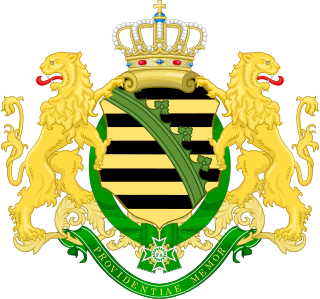
The Royal Saxon Army was the military force of the Electorate (1682–1807) and later the Kingdom of Saxony (1807–1918). A regular Saxon army was first established in 1682 and it continued to exist until the abolition of the German monarchies in 1918. With the formation of the Confederation of the Rhine by Napoleon the Royal Saxon Army joined the French "Grande Armée" along with 37 other German states.

Étienne-Marie-Antoine Champion, comte de Nansouty was a French cavalry commander during the French Revolutionary Wars who rose to the rank of General of Division in 1803 and subsequently held important military commands during the Napoleonic Wars.
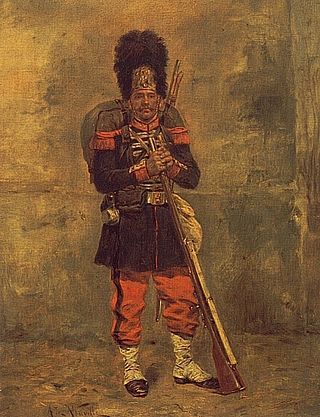
The Imperial Guard of Napoleon III was a military corps in the French Army formed by Napoleon III as a re-establishment of his uncle Napoleon I's Imperial Guard, with an updated version of the original uniforms and almost the same privileges.
Général Baron Claude Testot-Ferry was a cavalry veteran of the armies of the First French Republic, First French Empire and Bourbon Restoration.

The Mounted Grenadiers of the Imperial Guard was a heavy cavalry regiment in the Consular, then Imperial Guard during the French Consulate and First French Empire respectively. They were the senior Old Guard cavalry regiment of the Imperial Guard and from 1806 were brigaded together with the Dragoons of the Imperial Guard.
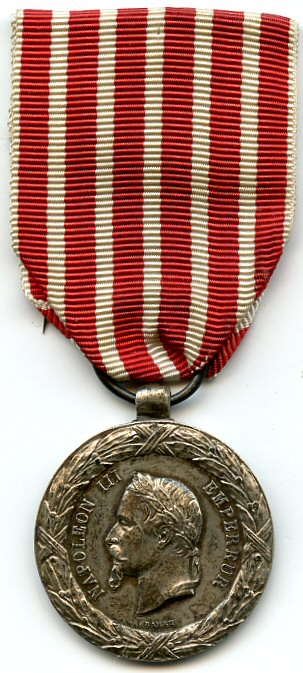
The Commemorative medal of the 1859 Italian Campaign was a French commemorative medal established by Napoleon III, following the 1859 French campaign in Italy during the Second Italian War of Independence.
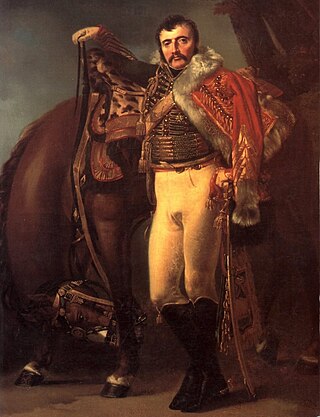
Claude-Étienne, comte Guyot was a French general of the French Revolutionary Wars and Napoleonic Wars, noted for commanding cavalry.

The Mounted Chasseurs of the Imperial Guard constituted a light cavalry regiment in the Consular, then Imperial Guard during the French Consulate and First French Empire respectively. They were the second senior "Old Guard" cavalry regiment of the Imperial Guard, after the Grenadiers à Cheval. The regiment had its origins in the Guides raised by General Bonaparte during his Italian campaign of 1796. It was the Chasseurs that usually provided personal escort to Napoleon, and he often wore the uniform of the regiment in recognition of this service. The regiment was not only known for its lavish uniform, but its combat history as well.

Arnaud Ernest Junqua, was a French officer of the Légion d'Honneur, captain of the cavalry regiment of the French Imperial Guard and Chief in second of the Cent-gardes Squadron. In the history of the squadron, Captain Junqua is described as an excellent human being, enough to tell true or invented stories, often invented, which were the joy of his comrades.
Jean Jules Bousson was a French officer of the Cent-gardes Squadron.

The Cent-gardes Squadron, also called Cent Gardes à Cheval, was an elite cavalry squadron of the Second French Empire primarily responsible for protecting the person of the Emperor Napoleon III, as well as providing security within the Tuileries Palace. It also provided an escort for the emblems of the Imperial Guard and their award ceremony with flag and standard bearers.

The Mamelukes of the Imperial Guard were a light cavalry unit of Egyptian origin that served in Napoleon’s Imperial Guard from 1801 to 1815. It was the third cavalry formation integrated into the Guard and its first foreign component. Initially recruited during the Egyptian campaign, the Mamelukes were repatriated with the French troops to metropolitan France where they were organized into a squadron, later reduced to a simple company. The various spellings of the squadron's name include Mamelukes, Mamluks, Mamelouks and Mameloucks.
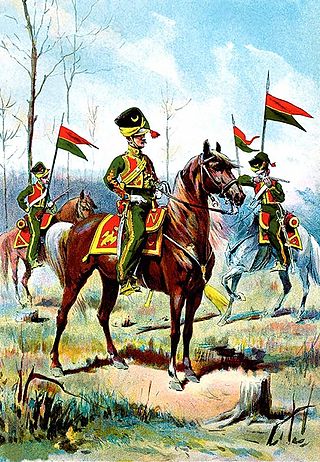
The Lithuanian Tatars of the Imperial Guard were a light cavalry squadron of Napoleon's Imperial Guard, in the service of the French Army from 1812 to 1814. The Lipka Tatars, descendants of Crimean Tatars, were organized into a single squadron at the beginning of the Russian Campaign. Their first commander was Squadron Leader Achmatowicz, who was killed at Vilnius and succeeded by Captain Ulan, who led the unit through the remainder of the war. Following the First Abdication of Napoleon, all foreign units were disbanded, and the regiment followed.
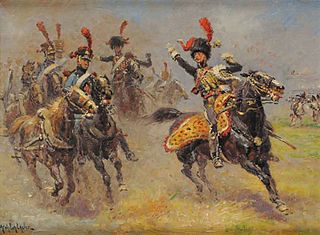
The Imperial Guard Artillery was made up of the organic units of the Imperial Guard of Napoleon I's's. It comprised a regiment of horse artillery, regiments of foot artillery and a train service responsible for supplying guns with powder and ammunition.

The regiment Lancers of the Imperial Guard was a French cavalry unit of the Second Empire, forming part of the Imperial Guard. Set up in 1855, it was disbanded with the rest of the Guard by decree on October 28, 1870.

The Chasseurs on Horse of the Young Guard,, were a light cavalry unit of the Imperial Guard, formed by Napoleon I and serving in the French army from 1813 to 1814, as well as during the Hundred Days.

The Imperial Guardcavalry corresponds to all the military cavalry units belonging to Napoleon I's Imperial Guard. An elite fighting unit, it became the army's ultimate reserve. It was used as a last resort to deliver the coup de grâce or break the deadlock in perilous situations. In 1804, the Imperial Guard cavalry initially comprised three units: mounted grenadiers, mounted chasseurs, and mamelukes. Subsequently, other cavalry corps joined the Imperial Guard, such as the dragoons in 1806, the Polish lancers in 1807, the red lancers in 1810, the Lithuanian lancers and Lithuanian tatars in 1812, and the scouts in 1813. Other cavalry units were attached to the Imperial Guard or served alongside it, such as the elite gendarmes, the gendarmes d'ordonnance, the chevau-légers de Berg, and the guards of honour. At the height of the First Empire in 1812, the Imperial Guard numbered around 7,000 cavalrymen, while the Grande Armée as a whole numbered approximately 77,000. From its creation until 1813, the Guard cavalry was commanded by Marshal Jean-Baptiste Bessières, Duke of Istria. Killed by a cannonball at the start of the German campaign, his command was taken over by General Nansouty.


















